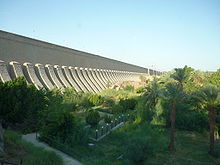- Aswan Low Dam
-
For the higher Aswan Dam completed upstream in 1970, see Aswan Dam.
Aswan Low Dam
Aswan Low DamOfficial name Aswan Low Dam Location Egypt Coordinates 24°02′02″N 32°51′57″E / 24.03389°N 32.86583°ECoordinates: 24°02′02″N 32°51′57″E / 24.03389°N 32.86583°E Construction began 1899 Opening date 1902 Owner(s) Egypt Dam and spillways Type of dam Gravity, masonry buttress Height 36 metres (118 ft) Length 1,950 metres (6,398 ft) Impounds River Nile Type of spillway Floodgates Reservoir Creates tailwater of Lake Nasser Capacity 5,300,000,000 cubic metres (4,296,780 acre·ft) Power station Commission date 1960, 1980-85 Turbines 11 Installed capacity 592 MW (Aswan I,II) The Aswan Low Dam or Old Aswan Dam is a gravity masonry buttress dam on the Nile River in Aswan, Egypt. The dam was built at the former first cataract of the Nile, and is located about 1000 km up-river and 690 km (direct distance) south-southeast of Cairo. Constructed between 1899 and 1902, it was intended to reduce flooding and to support population growth in the lower Nile. The dam provided inadequate flood protection and was raised twice, between 1907–1912 and 1929–1933. The alterations did not suffice and it was nearly over-topped in 1946 which led to the construction of the Aswan High Dam 6 kilometres (4 mi) upstream.[1]
Contents
Background
The earliest recorded attempt to build a dam near Aswan was in the 11th century, when the Iraqi polymath and engineer Ibn al-Haytham (known as Alhazen in the West) was summoned to Egypt by the Fatimid Caliph, Al-Hakim bi-Amr Allah, to regulate the flooding of the Nile, a task requiring an early attempt at an Aswan Dam.[2] After his field work convinced him of the impracticality of this scheme,[3] and fearing the Caliph's anger, he feigned madness. He was kept under house arrest from 1011 until al-Hakim's death in 1021, during which time he wrote his influential Book of Optics.
Construction
Following their 1882 invasion and occupation of Egypt, the British began construction of the first dam across the Nile in 1898. Construction lasted until 1902, and it was opened on 10 December 1902, by HRH the Duke of Connaught and Strathearn. The project was designed by Sir William Willcocks and involved several eminent engineers of the time, including Sir Benjamin Baker and Sir John Aird, whose firm, John Aird & Co., was the main contractor.[4][5]
The Old Aswan Dam was designed as a gravity-buttress dam; the buttress sections accommodate numerous gates, which were opened yearly to pass the flood and its nutrient-rich sediments, but without retaining any yearly storage. The dam was constructed of rubble masonry and faced with red ashlar granite. When constructed, the Old Aswan Dam was the largest masonry dam in the world.[6] The design also included a navigation lock of similar construction on the western bank, which allowed shipping to pass upstream as far as the second cataract, before a portage overland was required. At the time of its construction, nothing of such scale had ever been attempted.[7] Despite initial limitations imposed on its height, due to concern for the Philae Temple, the initial construction was soon found to be inadequate for development needs, and the height of the dam was raised in two phases, 5 meters between 1907–1912 and 9 meters between 1929–1933, and generation of electricity was added. With its final raising, the dam is 1,950 m in length, with a crest level 36 m above the original riverbed;[6] the dam provides the main route for traffic between the city and the airport. With the construction of the High Dam upstream, the Old Dam's ability to pass the flood's sediments was lost, as was the serviceability provided by the locks. The previous Old Dam reservoir level was also lowered and now provides control of tailwater for the High Dam.
Power plants
The Aswan Low Dam supports two hydroelectric power plants, Aswan I (1960) and Aswan II (1985–1986). Aswan I contains 7 X 46 MW generators with Kaplan turbines for a combined capacity of 322 MW and is located west of the dam. Aswan II contains 4 x 67.5 MW generators for an installed capacity of 270 MW and is located at the toe of the dam.[8]
Further reading
- Sidney Peel, The Binding of the Nile and the new Soudan, Oxford 1904. Discusses 'Assouan' Dam and Nile River development.
- The Assuan Dam, Journal of the Royal African Society, Vol. 12, No. 46, January, 1913
- Hanbury Brown, Irrigation; its principles and practice as a branch of engineering, Third Edition, London. 1920
References
- ^ "The First Aswan Dam". University of Michigan. http://www.umich.edu/~kelseydb/Exhibits/AncientNubia/PhotoIntro.html. Retrieved 2 January 2011.
- ^ Rashed, Roshdi (2002-08-02), "PORTRAITS OF SCIENCE: A Polymath in the 10th Century", Science (Science magazine) 297 (5582): 773, doi:10.1126/science.1074591, PMID 12161634, http://www.sciencemag.org/cgi/content/full/297/5582/773, retrieved 2008-09-16
- ^ Corbin, Henry (1993; original French 1964), History of Islamic Philosophy, Translated by Liadain Sherrard, Philip Sherrard, London; Kegan Paul International in association with Islamic Publications for The Institute of Ismaili Studies, p. 149, ISBN 0710304161
- ^ Egypt bond
- ^ Roberts, Chalmers (December 1902), "Subduing the Nile", The World's Work: A History of Our Time V: 2861–2870, http://books.google.com/books?id=DoDNAAAAMAAJ&pg=PA2861, retrieved 2009-07-10
- ^ a b V. Novokshshenov, Laboratory studies of the stone masonry in the Old Aswan Dam, Materials and Structures 1993, Vol. 26, p. 103-110
- ^ Frederic Courtland Penfield, Harnessing the Nile, Century Magazine, Vol. 57, No. 4 (February 1899)
- ^ "Aswan Dam (1,2) Electric Hydro Power Plant". Egypt Ministry of Energy and Electricity. http://www.moee.gov.eg/english/elshabaka/Aswan%20Dam%20%281,2%29.htm. Retrieved 2 January 2011.
Categories:- Aswan
- Aswan Governorate
- Nile
- 1902 architecture
- Dams in Egypt
- Hydroelectric power stations in Egypt
- Gravity dams
Wikimedia Foundation. 2010.

